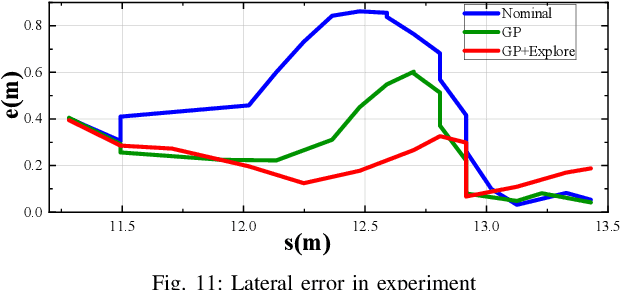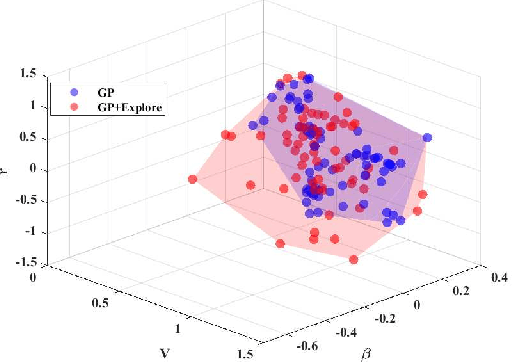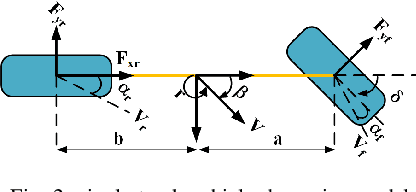Zhouheng Li
Adaptive Learning-based Model Predictive Control Strategy for Drift Vehicles
Feb 07, 2025Abstract:Drift vehicle control offers valuable insights to support safe autonomous driving in extreme conditions, which hinges on tracking a particular path while maintaining the vehicle states near the drift equilibrium points (DEP). However, conventional tracking methods are not adaptable for drift vehicles due to their opposite steering angle and yaw rate. In this paper, we propose an adaptive path tracking (APT) control method to dynamically adjust drift states to follow the reference path, improving the commonly utilized predictive path tracking methods with released computation burden. Furthermore, existing control strategies necessitate a precise system model to calculate the DEP, which can be more intractable due to the highly nonlinear drift dynamics and sensitive vehicle parameters. To tackle this problem, an adaptive learning-based model predictive control (ALMPC) strategy is proposed based on the APT method, where an upper-level Bayesian optimization is employed to learn the DEP and APT control law to instruct a lower-level MPC drift controller. This hierarchical system architecture can also resolve the inherent control conflict between path tracking and drifting by separating these objectives into different layers. The ALMPC strategy is verified on the Matlab-Carsim platform, and simulation results demonstrate its effectiveness in controlling the drift vehicle to follow a clothoid-based reference path even with the misidentified road friction parameter.
Reduce Lap Time for Autonomous Racing with Curvature-Integrated MPCC Local Trajectory Planning Method
Feb 06, 2025



Abstract:The widespread application of autonomous driving technology has significantly advanced the field of autonomous racing. Model Predictive Contouring Control (MPCC) is a highly effective local trajectory planning method for autonomous racing. However, the traditional MPCC method struggles with racetracks that have significant curvature changes, limiting the performance of the vehicle during autonomous racing. To address this issue, we propose a curvature-integrated MPCC (CiMPCC) local trajectory planning method for autonomous racing. This method optimizes the velocity of the local trajectory based on the curvature of the racetrack centerline. The specific implementation involves mapping the curvature of the racetrack centerline to a reference velocity profile, which is then incorporated into the cost function for optimizing the velocity of the local trajectory. This reference velocity profile is created by normalizing and mapping the curvature of the racetrack centerline, thereby ensuring efficient and performance-oriented local trajectory planning in racetracks with significant curvature. The proposed CiMPCC method has been experimented on a self-built 1:10 scale F1TENTH racing vehicle deployed with ROS platform. The experimental results demonstrate that the proposed method achieves outstanding results on a challenging racetrack with sharp curvature, improving the overall lap time by 11.4%-12.5% compared to other autonomous racing trajectory planning methods. Our code is available at https://github.com/zhouhengli/CiMPCC.
An Overtaking Trajectory Planning Framework Based on Spatio-temporal Topology and Reachable Set Analysis Ensuring Time Efficiency
Oct 30, 2024



Abstract:Generating overtaking trajectories in high-speed scenarios presents significant challenges and is typically addressed through hierarchical planning methods. However, this method has two primary drawbacks. First, heuristic algorithms can only provide a single initial solution, which may lead to local optima and consequently diminish the quality of the solution. Second, the time efficiency of trajectory refinement based on numerical optimization is insufficient. To overcome these limitations, this paper proposes an overtaking trajectory planning framework based on spatio-temporal topology and reachable set analysis (SROP), to improve trajectory quality and time efficiency. Specifically, this paper introduces topological classes to describe trajectories representing different overtaking behaviors, which support the spatio-temporal topological search method employed by the upper-layer planner to identify diverse initial paths. This approach helps prevent getting stuck in local optima, enhancing the overall solution quality by considering multiple initial solutions from distinct topologies. Moreover, the reachable set method is integrated into the lower-layer planner for parallel trajectory evaluation. This method enhances planning efficiency by decoupling vehicle model constraints from the optimization process, enabling parallel computation while ensuring control feasibility. Simulation results show that the proposed method improves the smoothness of generated trajectories by 66.8% compared to state-of-the-art methods, highlighting its effectiveness in enhancing trajectory quality. Additionally, this method reduces computation time by 62.9%, demonstrating its efficiency.
A Data-Driven Aggressive Autonomous Racing Framework Utilizing Local Trajectory Planning with Velocity Prediction
Oct 15, 2024Abstract:The development of autonomous driving has boosted the research on autonomous racing. However, existing local trajectory planning methods have difficulty planning trajectories with optimal velocity profiles at racetracks with sharp corners, thus weakening the performance of autonomous racing. To address this problem, we propose a local trajectory planning method that integrates Velocity Prediction based on Model Predictive Contour Control (VPMPCC). The optimal parameters of VPMPCC are learned through Bayesian Optimization (BO) based on a proposed novel Objective Function adapted to Racing (OFR). Specifically, VPMPCC achieves velocity prediction by encoding the racetrack as a reference velocity profile and incorporating it into the optimization problem. This method optimizes the velocity profile of local trajectories, especially at corners with significant curvature. The proposed OFR balances racing performance with vehicle safety, ensuring safe and efficient BO training. In the simulation, the number of training iterations for OFR-based BO is reduced by 42.86% compared to the state-of-the-art method. The optimal simulation-trained parameters are then applied to a real-world F1TENTH vehicle without retraining. During prolonged racing on a custom-built racetrack featuring significant sharp corners, the mean velocity of VPMPCC reaches 93.18% of the vehicle's handling limits. The released code is available at https://github.com/zhouhengli/VPMPCC.
Learning to Race in Extreme Turning Scene with Active Exploration and Gaussian Process Regression-based MPC
Oct 08, 2024



Abstract:Extreme cornering in racing often induces large side-slip angles, presenting a formidable challenge in vehicle control. To tackle this issue, this paper introduces an Active Exploration with Double GPR (AEDGPR) system. The system initiates by planning a minimum-time trajectory with a Gaussian Process Regression(GPR) compensated model. The planning results show that in the cornering section, the yaw angular velocity and side-slip angle are in opposite directions, indicating that the vehicle is drifting. In response, we develop a drift controller based on Model Predictive Control (MPC) and incorporate Gaussian Process Regression to correct discrepancies in the vehicle dynamics model. Moreover, the covariance from the GPR is employed to actively explore various cornering states, aiming to minimize trajectory tracking errors. The proposed algorithm is validated through simulations on the Simulink-Carsim platform and experiments using a 1/10 scale RC vehicle.
 Add to Chrome
Add to Chrome Add to Firefox
Add to Firefox Add to Edge
Add to Edge